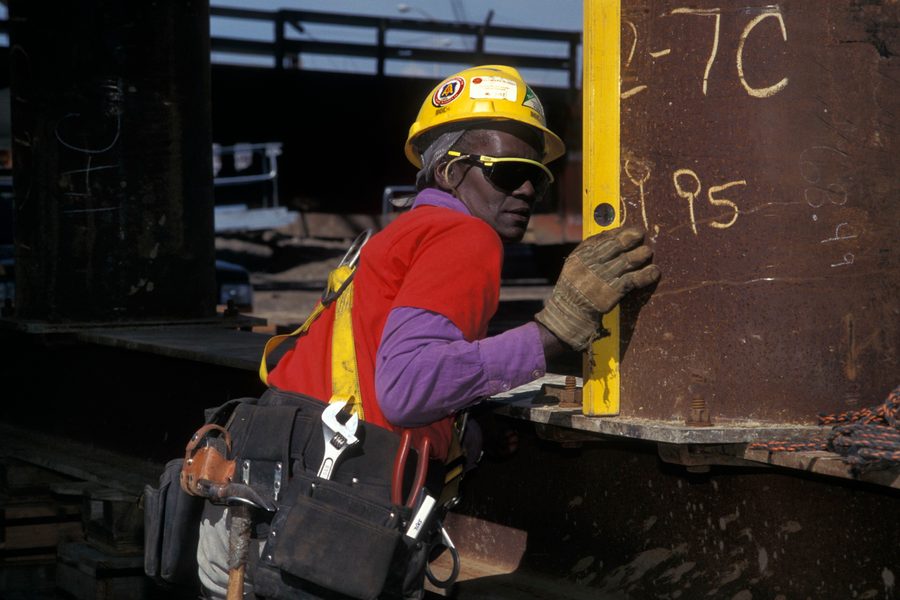How to Make the Building Trades Work for Women
From winning maternity leave to organizing against sexual harassment, union tradeswoman are pushing for change.
Mindy Isser

The building trades unions are some of the most powerful in the labor movement. Because their members are well-paid, their dues are often higher than in other unions, giving them more resources to influence change. They also hold a certain cultural cachet, exemplifying what many people (wrongly) think the working class looks like: white men in hard hats. But this cachet is also part of the problem: These unions have been under fire for how white and male-dominated they are. Only 6% of the construction workforce is Black and, as of 2018, only 3% of workers in the construction industry were women.
While building trades unions are working to address these issues, tradeswomen say that making construction unions more accessible — and comfortable — for women is going to be a long process. They say it will require material improvements, like widespread maternity leave protections, as well as cultural shifts, like working to end sexual harassment.
Ash Fritzsche is in year four of an apprenticeship program with International Brotherhood of Electrical Workers (IBEW) Local 98 in Philadelphia. She was working at a restaurant when some of her regular customers encouraged her to begin an apprenticeship in the building trades so she could have more job security and higher pay than in the food industry. Apprenticeships are not easy programs to get into: Fritzsche told In These Times that in her year, more than 1,000 people applied, but only fewer than 100 were accepted into this five-year program. Workers who complete apprenticeship programs are taught their craft while they work, earning a living while they complete the educational requirements and gain experience as electricians. To be accepted, workers must take an aptitude test and have an interview, which Fritzsche described as “killer, with seven guys at a roundtable asking you questions, it was so intimidating.” She struggled with knowing how to dress as a woman trying to break into the construction industry, having perused Reddit articles geared only towards men.
Fritzsche says her local accepted 10 women her year, contrasting with around three in years prior. She believes that allowing in more women helped with retention: “It allowed us to develop community. In previous years, at least one woman wouldn’t make it, but so far all 10 of us are still in and thriving and totally ambitious.”
At Local 98, apprentices start out making 30% of what journeymen make, which for her was $18 per hour. Raises are applied every 1,000 to 2,000 hours, and health insurance kicks in after a couple of months. Fritzsche is in the final year of her five-year apprenticeship and now makes $38 per hour, the most money she’s ever made. She told In These Times that she’ll get another raise in October, “and I know it. It’s not like if I show up early for work and I do this or that, I might get it. It’s an automatic, earned raise, which is the way it should be.” For women workers who may face gender discrimination (including lower pay, fewer benefits and fewer opportunities to advance) at work, unions can and do even the playing field.
Local 98 is working to recruit more women, and recently hosted a “Women in Construction” camp to teach more than 30 high-school aged young women about what union electrical work is like. But there is still work to be done. Because the building trades are so male-dominated, their unions are tailored to their members, who are primarily men. While benefits for unionized building trades workers are generous and desirable, most lack any kind of paid family leave — in our society, parental caretaking still falls primarily on women. This means that women may not see the building trades as a suitable career for them if they want to have a family.
But the International Union of Painters and Allied Trades (IUPAT) is working hard to change this: In May, the union introduced a maternity leave program. According to Jessica Podhola, the director of communications and government affairs at District Council 3 at IUPAT in the Kansas City area, members have to belong to their local district council’s health and welfare fund, and to have worked 100 hours immediately before the benefit is applied to be eligible for it. The program includes wage replacement of 67% or $800 per week, and if members cannot work during pregnancy, they can receive up to six months of paid leave. For postpartum leave, workers receive either paid time off for six or eight weeks (if they had a C-section).
Podhola told In These Times that this maternity leave program is “a beginning, but it’s a strong beginning.” Others, meanwhile, are picking up the baton. According to Fritzsche, Local 98 is also working on this issue: She told In These Times that the local recently extended the cap on disability from $300 to $500 dollars a week, and it made an automatic disability clause for women in their 9th month of pregnancy and for the first six weeks postpartum (or eight weeks if they had a C-section). IBEW Local 48 in Oregon, meanwhile, introduced a new maternity leave program in January 2020, which offered workers 13 weeks of paid leave prior to birth and 13 weeks of paid leave after birth, which doubled the union’s previous benefit.
Podhola serves on IUPAT’s national women’s committee, which was built to develop policies to propel the union forward in protecting its women members. The committee has subcommittees on maternity leave, diversity and inclusion, recruitment, and marketing and retention. But along with the structural barriers for women in the trades, there’s also a cultural component that is difficult to fight: sexual harassment and other instances of sexism at work. Kelly Ireland, a plumber in Local 690 in Philadelphia, says “you walk through job sites and see graffiti about women. They say it’s a joke, but how many decades have we asked you to stop joking?”
Unions are working on this, too. Ireland told In These Times that she knew of a man kicked off a job site for catcalling; the foreman fired him on the spot. And in addition to its new maternity leave policy, the IUPAT women’s committee is working on rolling out a sexual harassment training through their apprenticeship program.
Podhola told In These Times that “changing the culture in construction is a long-term project. We are not going to be able to get it done overnight, but we can begin to create safer work spaces and frameworks for our sisters to address issues as they come up, and to begin laying the foundation for members regardless of gender about what is acceptable and what is not on a modern construction site.”
Fritzsche’s experience has been similar during her apprenticeship. “You just watch some women burn out with the baloney they have to deal with. At the same time, the guys are incredible friends and mentors. I have so many male mentors. If you can work past issues around gender, you will have access to a wonderful world of friends, teachers, and mentors.”
According to Podhola, “Some of these guys have been doing this for 30 years and they’ve only worked with a woman a handful of times. It’s going to be a generational shift.” To make this shift happen, more women need to enter the trades. But it can be a vicious cycle: Women don’t see enough tradeswomen, so don’t see themselves as potential tradeswomen.
Ireland, who grew up with a union plumber for a father, never even considered a future in the trades until she had her own family — mostly because she never saw women like her doing the work. “If I was young and saw women in the trades, I would have gone into ironwork, climb skyscrapers.”
All of the tradeswomen who spoke to In These Times mentioned access as the largest barrier to bringing more women into the building trades: Women need to hear about these great jobs, understand that they’re just as welcome as men, and be given the confidence and tools both to apply and to stick it out when it gets difficult. Podhola says that “it’s on the onus of labor to market, recruit, and retain as many women as possible.”
Workers say other solutions outside of marketing and recruitment could include more local women’s committees that prioritize and work directly on issues that affect women workers, putting more women on interview committees so women who apply for apprenticeships see themselves in their union and, of course, quotas and affirmative action for apprenticeships.
But ultimately, tradeswomen want other women to know that they belong in the trades. Fritzsche told In These Times that “women make great tradespeople. We are really good at this work and we deserve this work. A woman invented the circular saw. A woman invented the modern band saw. During World War II, we filled factories, we took over all the trades. We are tradespeople just as much as men are.”








